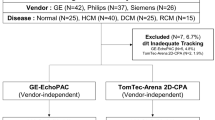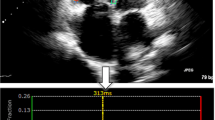Abstract
Global peak systolic longitudinal strain (PLS) derived from speckle tracking echocardiography (STE) is a widely used left ventricular deformation parameter. Modern ultrasound systems with improved temporal resolution and new software now allow automated multilayer analysis; however, there is limited evidence regarding its reproducibility. We performed intra- and inter-observer analyses within a population-based cohort study using conventional quantitative strain analysis (GE Healthcare). Fifty patients (49 ± 14 years) were randomly selected among the fourth visit of the STANISLAS Cohort. Multilayer PLS (transmural, subendocardial, and subepicardial), and strain rate (peak systolic, early and late diastolic) were evaluated. Peak systolic shortening (PSS) and early positive systolic strain (EPS) were calculated, as well as post-systolic index (PSI) and pre-stretch index (PST), two additional strain-derived parameters. Intra-observer intraclass correlation coefficients (ICC) were >0.75 for all analyzed parameters. The mean relative intra-observer differences were <5% for all considered parameters, and their 1.96 SDs were <15% for multilayer PLS, strain rate and PSS, but not for EPS, PSI and PST. Inter-observer ICCs were >0.70 (the majority being >0.80). The mean relative inter-observer differences were <7.5% for all considered parameters, with 1.96 SDs of relative differences being <21% for multilayer PLS, strain rate and PSS, but not for EPS, PSI and PST. In this population-based study, in subjects without or with a limited number of cardiovascular risk factors and no previous cardiovascular events, deformation parameters were found to be highly reproducible, except for EPS, PSI and PST, which showed moderately higher variability. Quantitative strain analysis appears to be an effective clinical and research tool, providing insights regarding longitudinal deformation using a simple three-step post-processing procedure.




Similar content being viewed by others
References
Mor-Avi V, Lang RM, Badano LP, Belohlavek M, Cardim NM, Derumeaux G et al (2011) Current and evolving echocardiographic techniques for the quantitative evaluation of cardiac mechanics: ASE/EAE consensus statement on methodology and indications endorsed by the Japanese Society of Echocardiography. Eur J Echocardiogr 12(3):167–205
Cheng S, Larson MG, McCabe EL, Osypiuk E, Lehman BT, Stanchev P et al (2013) Reproducibility of speckle-tracking-based strain measures of left ventricular function in a community-based study. J Am Soc Echocardiogr 26(11):1258–1266
Rodríguez-Bailón I, Jiménez-Navarro MF, Pérez-González R, García-Orta R, Morillo-Velarde E, de Teresa-Galván E (2010) Left ventricular deformation and two-dimensional echocardiography: temporal and other parameter values in normal subjects. Rev Esp Cardiol 63(10):1195–1199
Castel A-L, Szymanski C, Delelis F, Levy F, Menet A, Mailliet A et al (2014) Prospective comparison of speckle tracking longitudinal bidimensional strain between two vendors. Arch Cardiovasc Dis 107(2):96–104
Yingchoncharoen T, Agarwal S, Popović ZB, Marwick TH (2013) Normal ranges of left ventricular strain: a meta-analysis. J Am Soc Echocardiogr 26(2):185–191
Leitman M, Lysiansky M, Lysyansky P, Friedman Z, Tyomkin V, Fuchs T et al (2010) Circumferential and longitudinal strain in 3 myocardial layers in normal subjects and in patients with regional left ventricular dysfunction. J Am Soc Echocardiogr 23(1):64–70
Jasaityte R, Claus P, Teske AJ, Herbots L, Verheyden B, Jurcut R et al (2013) The slope of the segmental stretch-strain relationship as a noninvasive index of LV inotropy. JACC Cardiovasc Imaging 6(4):419–428
Lang RM, Badano LP, Mor-Avi V, Afilalo J, Armstrong A, Ernande L et al (2015) Recommendations for cardiac chamber quantification by echocardiography in adults: an update from the American Society of Echocardiography and the European Association of Cardiovascular Imaging. J Am Soc Echocardiogr 28(1):1–39
Voigt J-U, Pedrizzetti G, Lysyansky P, Marwick TH, Houle H, Baumann R et al (2015) Definitions for a common standard for 2D speckle tracking echocardiography: consensus document of the EACVI/ASE/Industry Task Force to standardize deformation imaging. J Am Soc Echocardiogr 28(2):183–193
Bland JM, Altman DG (1986) Statistical methods for assessing agreement between two methods of clinical measurement. Lancet 1(8476):307–310
Moen CA, Salminen P-R, Dahle GO, Hjertaas JJ, Grong K, Matre K (2013) Multi-layer radial systolic strain vs. one-layer strain for confirming reperfusion from a significant non-occlusive coronary stenosis. Eur Heart J Cardiovasc Imaging 14(1):24–37
Ozawa K, Funabashi N, Kamata T, Kobayashi Y (2016) Inter- and intraobserver consistency in LV myocardial strain measurement using a novel multi-layer technique in patients with severe aortic stenosis and preserved LV ejection fraction. Int J Cardiol 228:687-693
Altiok E, Neizel M, Tiemann S, Krass V, Becker M, Zwicker C et al (2013) Layer-specific analysis of myocardial deformation for assessment of infarct transmurality: comparison of strain-encoded cardiovascular magnetic resonance with 2D speckle tracking echocardiography. Eur Heart J Cardiovasc Imaging 14(6):570–578
Sarvari SI, Haugaa KH, Zahid W, Bendz B, Aakhus S, Aaberge L et al (2013) Layer-specific quantification of myocardial deformation by strain echocardiography may reveal significant CAD in patients with non-ST-segment elevation acute coronary syndrome. JACC Cardiovasc Imaging 6(5):535–544
Engvall C, Henein M, Holmgren A, Suhr OB, Mörner S, Lindqvist P (2011) Can myocardial strain differentiate hypertrophic from infiltrative etiology of a thickened septum? Echocardiography 28(4):408–415
Nagueh SF, Middleton KJ, Kopelen HA, Zoghbi WA, Quiñones MA (1997) Doppler tissue imaging: a noninvasive technique for evaluation of left ventricular relaxation and estimation of filling pressures. J Am Coll Cardiol 30(6):1527–1533
Frikha Z, Girerd N, Huttin O, Courand PY, Bozec E, Olivier A et al (2015) Reproducibility in echocardiographic assessment of diastolic function in a population based study (the STANISLAS Cohort study). PloS One 10(4):e0122336
Nagueh SF, Sun H, Kopelen HA, Middleton KJ, Khoury DS (2001) Hemodynamic determinants of the mitral annulus diastolic velocities by tissue Doppler. J Am Coll Cardiol 37(1):278–285
Dandel M, Lehmkuhl H, Knosalla C, Suramelashvili N, Hetzer R (2009) Strain and strain rate imaging by echocardiography—basic concepts and clinical applicability. Curr Cardiol Rev 5(2):133–148
Carluccio E, Biagioli P, Alunni G, Murrone A, Leonelli V, Pantano P et al (2011) Advantages of deformation indices over systolic velocities in assessment of longitudinal systolic function in patients with heart failure and normal ejection fraction. Eur J Heart Fail 13(3):292–302
Marwick TH (2006) Measurement of strain and strain rate by echocardiography: ready for prime time? J Am Coll Cardiol 47(7):1313–1327
D’hooge J, Bijnens B, Thoen J, Van de Werf F, Sutherland GR, Suetens P (2002) Echocardiographic strain and strain-rate imaging: a new tool to study regional myocardial function. IEEE Trans Med Imaging 21(9):1022–1030
Edvardsen T, Skulstad H, Aakhus S, Urheim S, Ihlen H (2001) Regional myocardial systolic function during acute myocardial ischemia assessed by strain Doppler echocardiography. J Am Coll Cardiol 37(3):726–730
Amundsen BH, Helle-Valle T, Edvardsen T, Torp H, Crosby J, Lyseggen E et al (2006) Noninvasive myocardial strain measurement by speckle tracking echocardiography: validation against sonomicrometry and tagged magnetic resonance imaging. J Am Coll Cardiol 47(4):789–793
De Boeck BWL, Teske AJ, Meine M, Leenders GE, Cramer MJ, Prinzen FW et al (2009) Septal rebound stretch reflects the functional substrate to cardiac resynchronization therapy and predicts volumetric and neurohormonal response. Eur J Heart Fail 11(9):863–871
Jansen AHM, Bracke F, van Dantzig JM, Peels KH, Post JC, van den Bosch HCM et al (2008) The influence of myocardial scar and dyssynchrony on reverse remodeling in cardiac resynchronization therapy. Eur J Echocardiogr 9(4):483–488
Shah AM, Solomon SD (2012). Myocardial deformation imaging: current status and future directions. Circulation 125(2):244–248
Acknowledgements
The STANISLAS study (Clinical Trial: https://clinicaltrials.gov/ct2/show/NCT01391442; N°: NCT01391442) was sponsored by the Nancy CHU and the French Ministry of Health (Programme Hospitalier de Recherche Clinique Inter-régional 2013). The study was supported by the F-CRIN (F-Clinical Research Infrastructure Network) INI-CRCT (Cardiovascular and Renal Clinical Trialists) network. The authors deeply thank the entire Clinical Investigation Centre staff all of whom are involved in the daily management of the STANISLAS cohort. We thank all patients who participated in this study.
Author information
Authors and Affiliations
Corresponding author
Ethics declarations
Conflict of interest
The authors declared that they have no conflict of interest.
Electronic supplementary material
Below is the link to the electronic supplementary material.
Rights and permissions
About this article
Cite this article
Coiro, S., Huttin, O., Bozec, E. et al. Reproducibility of echocardiographic assessment of 2D-derived longitudinal strain parameters in a population-based study (the STANISLAS Cohort study). Int J Cardiovasc Imaging 33, 1361–1369 (2017). https://doi.org/10.1007/s10554-017-1117-z
Received:
Accepted:
Published:
Issue Date:
DOI: https://doi.org/10.1007/s10554-017-1117-z




